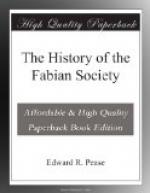[Illustration: GRAHAM WALLAS, IN 1891]
FOOTNOTES:
[30] Shaw has “vehemently protested” against this phrase, saying that he “put in six years of hard committee work to the astonishment of the vestrymen who had not expected (him) to be a man of business and a sticker at it.” But I am still of opinion that the secondary effects of those six years on his knowledge of affairs and the lessons he has drawn from them in his writings and speeches have been of greater value to his innumerable readers and hearers than was his administrative diligence to the Parish of St. Pancras.
[31] “Fabianism and the Empire,” p. 26.
[32] “The Fabian Society and the War: reply by the majority of the Executive Committee to the recent circular.” (Circular on the referendum mentioned later.)
Chapter VIII
Education: 1902-5, and the Labour Party: 1900-15
Housing—“The Education
muddle and the way out”—Supporting
the
Conservatives—The Education
Acts of 1902 and 1903—Feeding School
Children—The Labour Representation
Committee formed—The Fabian
Election Fund—Will Crooks
elected in 1910—A Fabian Cabinet
Minister—Resignation
of Graham Wallas—The younger generation:
H.W.
Macrosty, J.F. Oakeshott, John
W. Martin—Municipal Drink
Trade—Tariff Reform—The
Decline of the Birth-rate.
The controversy described in the preceding chapter was not the only business that occupied the Society at the period of the South African War.
Amongst minor affairs was a change of premises. The office first taken, in 1891, was at 276 Strand, in the island at that time formed by Holywell Street which ran between the churches of St. Clement Danes and St. Martin’s in the Fields. At the end of 1899 the London County Council acquired the property for the Kingsway and Aldwych clearance scheme, and we found new quarters in a basement at Clement’s Inn, a pleasant couple of rooms, with plenty of light, though sometimes maliciously misdescribed as a cellar. At the end of 1908 we removed into three much more spacious rooms at the same address, also in “a dismal basement,” where we remained until in 1914 the Society rented a house at 25 Tothill Street, Westminster.
Another undertaking was a conference on Housing. Although the first public effort of the Society was its conference at South Place Chapel in 1886, this particular form of propaganda has never commended itself to the Executive, chiefly no doubt because conferences, to which numerous representative persons are invited, are most useful for promoting moderate reforms which have already made themselves acceptable to the members and officials of local governing bodies. Such reforms the Fabian Society does not regard as its special business; it prefers to pioneer; it is true that it uses its machinery for spreading a knowledge of local government in all its forms, but that is mainly a matter of office routine.




